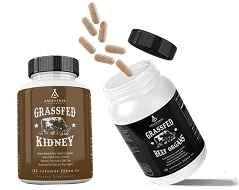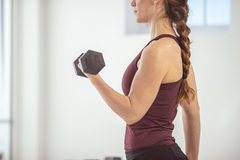Move More... Like Our Early Ancestors Did!
MOVE MORE... LIKE OUR EARLY ANCESTORS DID!

Take a moment and think about how you spend your day. More specifically, think about how you move throughout that day.
You wake up in the morning and get ready for work, just to sit in the car and make your way through traffic – if you live in an area like me, this might take you an hour or more. Once you get to the office, you might spend hours at your desk reviewing emails and completing assignments. After you get home, you probably make dinner, tidy up a bit, and then relax on the couch to watch some Netflix or browse the web on your phone – you could even be hunched over your phone right now, reading this article!
How much time do you spend sitting, between your car and your desk and the couch in the evenings? How much time do you spend lying down, either napping or watching TV or sleeping at night? Now, how much time do you spend really moving? If I had to guess – and if you’re anything like the typical American – the balance is seriously off.
We aren’t moving anything like our ancestors once did, which creates more evolutionary mismatch problems than you would imagine. In fact, it might even be just as detrimental to our health as our modern, non-ancestral diets.
How Our Ancestors Moved
As you can probably imagine, our ancestors moved a lot. Think about it: if they didn’t get out there and hunt or gather food, they would starve. Thirsty? They usually had a good hike just to collect water from a fresh stream or spring, plus carrying some back for others. Nomad tribes were on the move all the time, following both food sources and migrating for specific seasons, carrying everything they owned (including their small children) in the process.
In order to survive, shelter was necessary. For some, this meant climbing and sleeping in trees at night to avoid predators – young and old alike. For others, this meant building structures with their own hands, searching and gathering the supplies necessary. Then, of course, there was the cooking, clothing- and tool-making, and the fighting off of wild animals looking for their next meal.
Life was rough... life was very physical... life was in harmony with nature. While children still played games and explored, they also worked; they were gathering with their mothers, learning to hunt with their fathers, and helping to protect the family from a very young age. They were walking for miles along with the rest of their tribe, and they were even climbing trees for protection at night.
There wasn’t much time for sitting and relaxing, and you better believe that no one’s job involved hunching over a rock, or even a stone tablet, for eight hours a day.
Comment: I believe that comfort is not good for any organism. I also believe that rest and relaxation, storytelling, drums beating and dance were integral to forming tribal bonds, teaching and creating connecting purpose. My point is that our early ancestors earned their rest and relaxation and then they "moved" in rthym and in harmony with one another, and with nature.
How We Move
It goes without saying that today, we move nothing like our ancestors. And the health effects of this sedentary lifestyle are significant.
I personally put a huge emphasis on moving throughout the day, and I know that it’s still not enough – after all, I’m sitting at my desk right now as I write this article. And those who simply don’t have the time or ability (or don’t really think it’s that important) to do the same as me? Well, they are decreasing their life expectancy and destroying their health, just by not moving enough.
Between the average commute (which adds up to over 229 hours a year), sitting at a desk at work, gaming/reading/watching television at night, and spending time on a home computer, the average American is spending a horrifying 13 hours a day on their butt! Add in 8 hours of sleep a night (though few of us get that – a topic for another day), and you have an average of 21 hours a day that we spend totally inactive.
Honestly, it’s shocking to think about.
Sure, some of us try to make this up by walking around occasionally at work or hitting the treadmill each evening, but our health is still suffering. Many studies have even found that we can’t really “make up” for hours and hours of sedentariness just by hitting the gym after work – that much of the damage is already done, and an hour on the elliptical simply can’t undo 10+ hours of inactivity.
The fact is, modern humans just don’t move the way our bodies were intended to move… and we are getting sicker and sicker as a result.
Why It Matters
There are so many reasons why it’s important to move like our ancestors did. They range from the superficial (we burn more calories, have better posture, do better thinking) to the life-altering (we can help avoid cancer, diabetes, and metabolic disorders). It’s quite literally a matter of life and death.
When you’re sedentary for hours at a time, your metabolism slows down. You’re not burning as many calories, increasing your heart rate through exertion, or working your muscles, so your body doesn’t need to work quite as hard. Your metabolism slows and you can even begin to see the effects in your endocrine system, which is most often in the form of diabetes.
In fact, the combination of all of these effects – and their direct correlation to a sedentary lifestyle – have led researchers to coin it “sitting disease.”
Movement also releases antioxidants that fight free radicals, helping you avoid cancer. Bones require constant movement in order to maintain their strength, and sitting for too long impacts that. Alternating between sitting and standing helps your body release the enzymes needed to properly digest your food. Subtle movements promote higher HDL and lower LDL, helping you avoid heart disease. Not to mention, increasing your circulation with physical activity releases endorphins (improving your mood), increases circulation (boosting energy levels and mental acuity), and flat-out reduces the back/joint/nerve pain that can come from sitting – a position our bodies weren’t meant to hold all day.
A shocking fact? The 4th leading risk factor for global mortality is physical inactivity, and more than 3 million deaths a year are related to sedentariness. Sitting at your desk all day can quite literally kill you.
Comment: Our physiology adapts to the environments that we create. With that said, we literally create new vascular physiology that's aligned with a sedentary life when we don't move enough. Inactivity (probably avoiding the sun too) is indeed the new smoking.
As to why it matters, I'd like to add this... What you do with your body is just as important as what you put into it... in maintaining a "healthy level of movement," one develops a healthy approach to consumption, where instincts become far more identifiable and beneficial. The well-being that builds from balanced movement trumps the need for consumption based satisfaction, such as food, pain killers, alcohol, drugs etc.
How to Fix the Imbalance
No matter your lifestyle or how much movement your job allows for, chances are that you can still do more. With the exception of very few careers, you probably aren’t getting in the amount of movement that your body was designed to have in a given day.
Even if you exercise regularly, you unfortunately can’t truly undo the hours you spend sitting on your butt, either. The sudden shift from 8+ hours of sitting to an hour of physical activity at the gym or at home is stark, too. Even though exercise is still recommended and will improve your heart/lung health, circulation, and blood sugar, it’s just not enough if you’re spending the rest of the entire day, sedentary.
Luckily, there are a number of ways that you can not only increase your movement each day but also improve your health, all without having to quit your job.
Move All Day Long
From the moment you open your eyes to the moment you close them, you should make a conscious effort to move. Whether you are running or doing resistance training, or simply engaging in small movements while you work, just make sure to get your blood pumping.
Before you get ready for the day, try to take a short walk. It will wake you up physically and mentally, and ramp up your metabolism from the offset. Maybe you find that the morning is the best time for you to work out, which can help jump start your physical activity for the day.
There’s no avoiding work for most of us. For some that also means a commute, and added hours in the car each week. Once you actually get to work, though, do your best to keep active. If you have the option of a walking or standing desk, take it! By simply changing your posture, opening up your blood circulation, and moving in a way that your body can while sitting, you’ll do your health a favor.
Take breaks to hit the water fountain or climb a few flights of stairs. If you can, eat lunch outside (bonus vitamin D!) and walk a few laps afterward. When you get home, play outside with the kids, take the dogs for a walk, or do some lawn work – whatever it takes to keep you moving and getting fresh air. After dinner, don’t just grab the remote or your iPad and plop down on the couch; practice some yoga or even engage in some, ahem, extracurricular activities with your spouse.
If you need to track your movement, you can opt for a pedometer or wearable like a FitBit. I personally don’t like the EMFs involved with such devices. However, it can be a great way to make sure you hit 10,000+ steps each day, at least until you learn how to gauge your activity on your own.
Moving constantly throughout the day is more important to your health than working out the recommended 150 minutes a week, though you should actually aim for both.
Comment: I tend to agree with Stephanie about wearable technology... don't do it, unless you absolutely need it to establish the habit (then, get it off your body). Perhaps of more importance is keeping track of the amount of time that you're moving and builing the cornerstone habits (e.g. walking first thing in the morning, after lunch, after dinner and plenty of movement snacks throughout the day).
30-Minute Rule
Whether at home or at work, you should aim to change your position every 30 minutes or so. If you’re working at a desk, alternate between sitting and standing once every half-hour. Take breaks to walk around at least this often, and try to avoid holding the same body position for more than this amount of time.
This switch allows you to use different sets of joints and muscles. It gets your blood circulating and increases the subtle movements needed to balance HDL/LDL and also release your body’s digestive enzymes. Plus, you’ll improve your mood and brain function in the process!
Comment: This is way better than any cup of coffee... plus, it'll save you a ton of money if you source your coffee like most people do in the modern world. Don't believe me... try it! Try moving more... I'm not asking you to put forth much effort here. I'm just asking you to put one foot in front of the other. Get those 10,000 steps a day (or) walk for 60 to 90 minutes. This is how I do it...
- First thing in the morning I walk for twenty to thirty minutes... this is that cup of coffee I was talking about
- Early afternoon I walk for twenty to thirty minutes... this is my afternoon nap
- After dinner our tribe walks in rain, snow or shine for thirty minutes
I also lift heavy things but this is supplemental to moving around at a slow pace. Get moving and take notice how other things fall into place.
Make Workouts Rough
Increasing your constant motion throughout the day is imperative; your life depends on it. However, it’s still important to implement true, strenuous physical exertion for at least 75 minutes a week.
In order to really boost your health, this work needs to be rough. If you’re just walking on the treadmill, you’re not getting the cardiovascular benefits that your heart and lungs need, even if you’re getting your steps in.
Our ancestors worked hard. Whether hauling everything they owned on their backs, chasing prey, or running from predators, their physical activity was hard. Make yours hard, too.
Rather than running at a steady state for an hour, utilize sprints instead. These quick-fire sessions will not only burn more calories in the end (let’s be honest, this is why most of us workout), but will improve our health in the process.
Sprints should be tough and high-intensity; if they’re not, you’re not working hard enough. Run for 20-30 seconds, follow this with 90 seconds of rest, and repeat 8 times. Do this 2-3 times a week, with ample rest in between – this is the type of exercise that most closely imitates the activity bursts that our hunter-gatherer ancestors would have had.
In addition to that, get your hands dirty whenever you can. Enjoy some manual labor, whether it’s helping a neighbor build a fence or digging a new garden for your parents. Get out in the fresh air, work with your bare hands, and sweat. There’s nothing better than the full-body ache that comes from something like that.
Comment: Like I previously mentioned, I believe that moving around at a slow pace is more important than strenuous physical exertion but I also lift heavy things and I do sprints every 7 to 10 days. I do this to honor my barbaric forefathers, to stay strong and robust... plus, the research shows that muscle mass is a key predictor of longevity.
Get the Family Involved
Our ancestors didn’t put in headphones and run alone on the treadmill for an hour. Their physical exertion was also a social affair, and had just as much to do for their mental and behavioral health as their physical. You can do the same.
This could be as simple as finding a workout partner, or you could get the entire family involved in your efforts to “just move.” Go outside and play in the yard with the kids… and do it barefoot! You’ll build strong bonds, socialize with loved ones, enjoy fresh air, soak up some vitamin D, and improve everyone’s health in the process. Doing so barefoot will allow your feet to strike naturally without constriction, the way they were built to move across the uneven earth, and you’ll also be grounding yourself in the process.
Our modern world doesn’t promote constant movement. Sure, we have Fitbits and Apple watches tracking our steps and we try to use our gym memberships a couple times a week, but that’s not enough. We simply can’t combat hours upon hours of a sedentary lifestyle, spent hunched over a desk, Netflixing on the couch, or scrolling through our smartphones in bed.
If you want to quite literally save your life, you need to MOVE like our ancestors. Find ways to incorporate movement into every single aspect of your day and eliminate sedentary activities like video games. You’ll improve both your social bonds and your physical health in the process, and live a healthier (longer) life as you do.
Comment: If you're a man, go to our "About Us" page for more ideas... scroll down to # FOR MEN ONLY. Here's a preview...



















